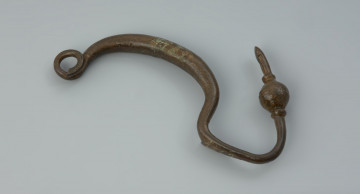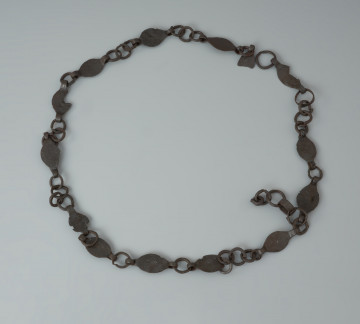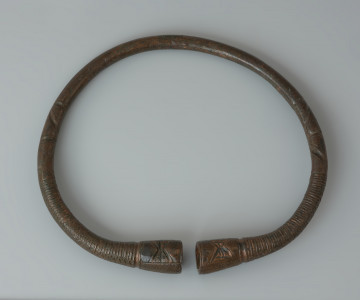
Buckle bail
BC 200 — 1
National Museum in Szczecin
Part of the collection: Antiquity
The iron fibula is triangular in shape, which is important to determine its dating, and it has a specific elbow-shaped bow with an artistically decorated rib. The fibulae have become a common element of both men’s and women’s garments in 3rd-2nd centuries B.C., slowly replacing pins that had been used for that purpose before. The oldest types of fibulae have simple constructions, resembling contemporary safety pins. Later designs are much more complex. A typology of early fibulae, together with their dating, has been developed in 1919 by a Polish archaeologist, Józef Kostrzewski. It is commonly used in European archaeological research up to this day. According to his findings, the presented specimen fits into the type “K”, which means that it can be dated to the 2nd/1st century B.C. The fibula comes from the assemblage of objects excavated in the Parsęck cemetery in Szczecin poviat. It has not been established whether it belonged to the grave goods or was found outside the grave. The circumstances of the discovery of the cemetery in Parsęck in the 2nd half of the 19th century are equally unclear. The site was excavated in 1870 by a local pastor Emil Kasiski, an amateur archaeologist and a volunteer conservationist. This was not the only such situation. Such people, most often local teachers, officials, clergymen, and also military men, created collections of historical monuments and conducted their own excavations, compensating in a way for the shortage of scientific personnel in Western Pomerania. The volunteers worked in cooperation with institutions such as museums in Szczecin and Stargard. Although pastor Krasicki carried out the excavations in accordance with the methodology valid at that time, it was still far from the contemporary standards, so there is no information on which relics were found in the goods of individual graves. It is very possible that two separate cemeteries, located very close to one another, were found in Parsęck, with both pit cremation graves and urned graves. They should be linked to the settlements of the Oksywa culture and dated to the 2nd-1st centuries B.C.
Bartłomiej Rogalski
Author / creator
Dimensions
cały obiekt: height: 2.3 cm, width: 9.2 cm
Object type
pin (fastener)
Technique
metallurgical; forging
Material
iron
Creation / finding place
Owner
Muzeum Narodowe w Szczecinie
Identification number
Location / status

BC 200 — 1
National Museum in Szczecin

National Museum in Szczecin

National Museum in Szczecin
DISCOVER this TOPIC
Castle Museum in Łańcut
DISCOVER this PATH
Educational path